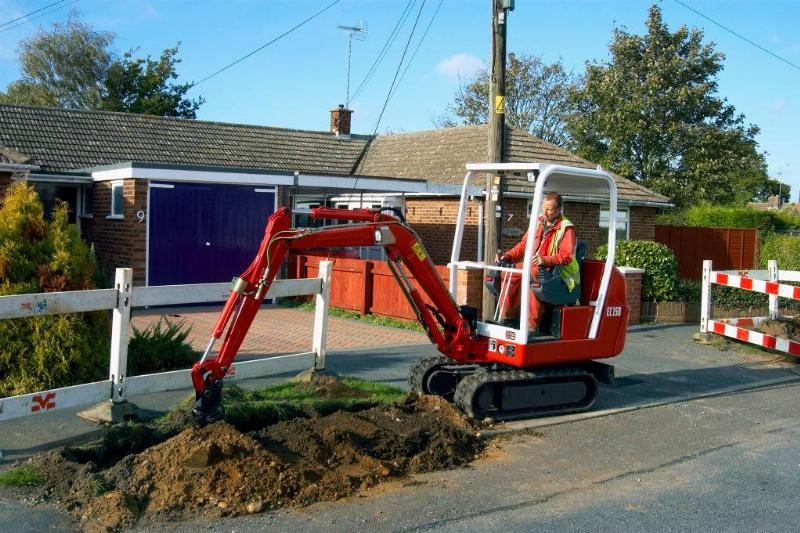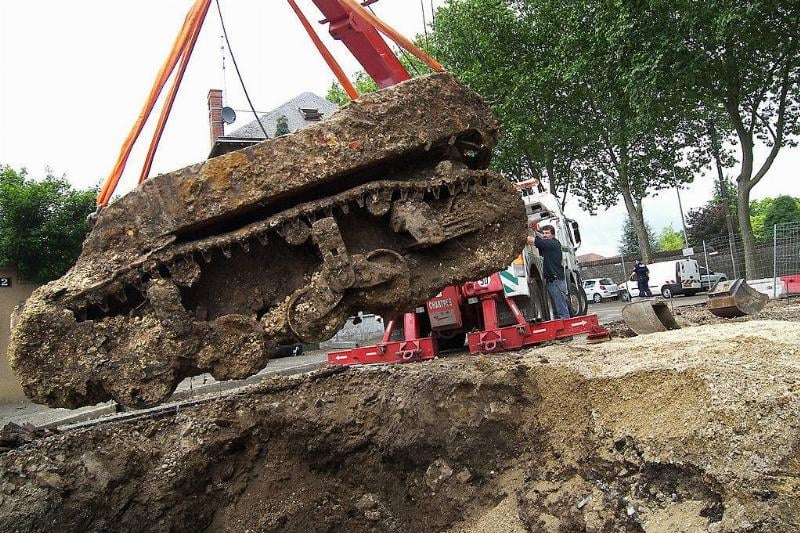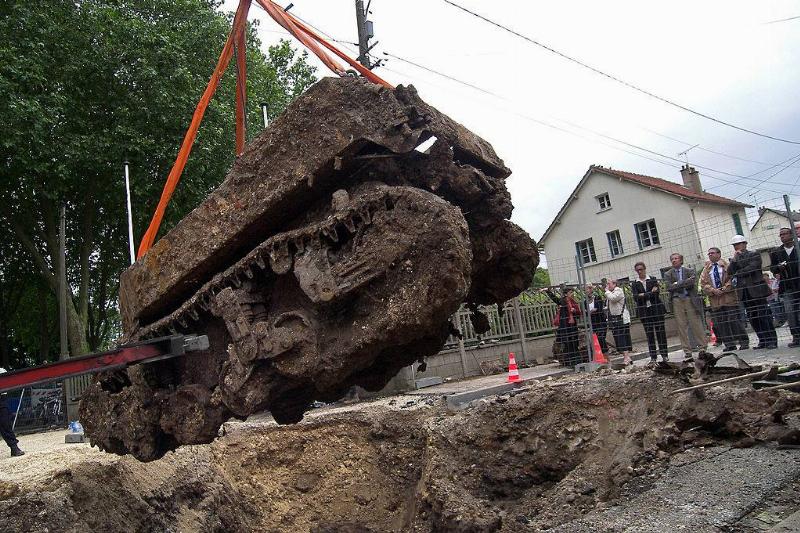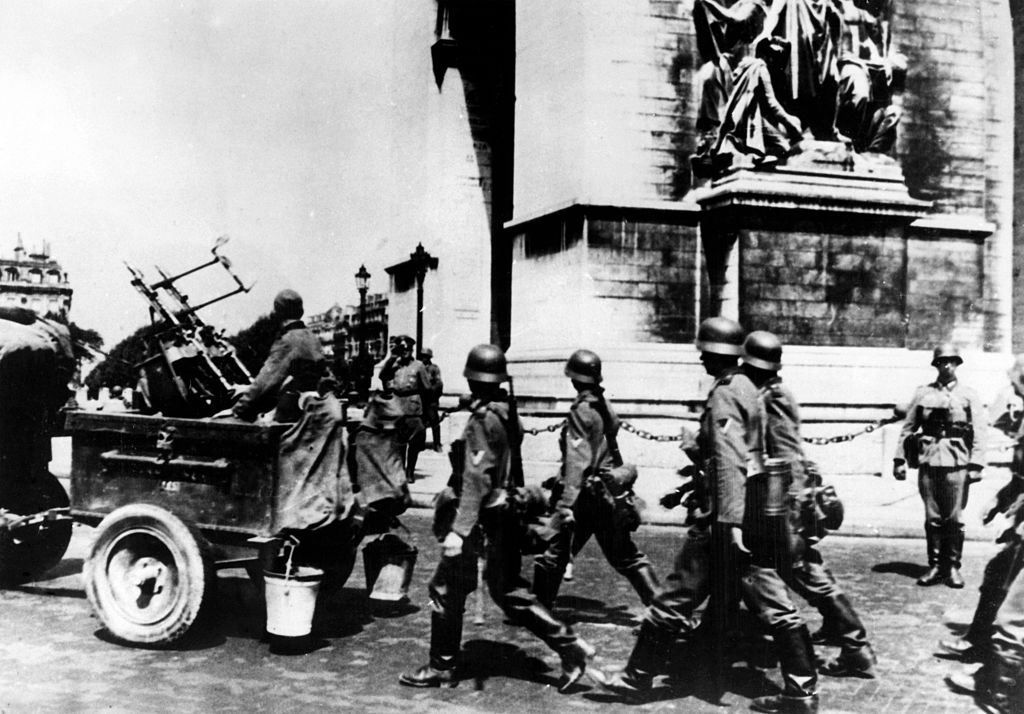Mysterious Underground World War II Relic Discovered Near Paris
Sometimes mysterious objects are discovered from the past that intrigue us and promote curiosity pertaining to their history. This particular story centers around a group of road workers in 2008 who were doing construction work 55 miles outside of Paris’ city limits. The workers dug up a gigantic object that they knew was of great historic importance.
What perplexing object could have possibly been discovered?
A Road Was Being Dug Up By Workers
Even though it’s been decades long since the Liberation of France, there have been many WWII sightings and discoveries that were uncovered. The items range anywhere from secret bunkers to stolen artwork and explosives among other things.

Source: BuildPix/Construction Photography/Avalon/ Getty Images
Despite the fact that it wasn’t surprising to find something from that time period, regardless, any discovery was thrilling. A group of construction workers were digging outside of Paris and knew they were in for a big treat after unearthing something buried deep underneath the street.
Investigation Underway By Experts
Once a few experts were called by the workers, they immediately were able to identify the object that was buried deep beneath the ground. Indeed, these experts confirmed that it was something historically significant. After working around the clock, over six decades of debris was uncovered.

Source: Alain Jocard/AFP via Getty Images
Amazingly, the special item was an Allied military tank from World War II that was used as an aid for the Liberation of France in 1944. So, how exactly did this tank become lost and remain underground for 60 plus years?
France’s Liberation Led To The Loss Of An Allied Tank
For four years, Germany retained control over France, but one military battle freed them from the shackles of the repressive German occupation. The French and their U.S. allies fought against Germany in the Liberation of Paris.

Source: Keystone/ Getty Images
The Liberation in Paris continued from August 19 to August 25,1944, with the Germans finally surrendering on the 25th. Unfortunately, there was another year of fighting in other areas of France, and, in between that time period, a bevy of logistical losses and other kinds of confusion were happening. Amidst all of that chaos, it’s understandable how a colossal tank suddenly disappeared.
Witnesses Wanted To Protect The Tank
The tank was clearly in bad shape because it was buried far under the ground for so many decades. Despite it being covered in dirt, rust, and general debris, it was still in good enough shape to be recognizable.

Source: Alain Jocard/AFP via Getty Images
The Daily Mail was informed by the experts that the lost tank was an M5, belonging to the American 31st Tank Battalion. Remarkably, they found witnesses who recalled seeing the tank during the Liberation in 1944 before it was hastily abandoned by the American soldiers.
The Story Behind The Tank’s Vanishing
Although there were witnesses who saw the tank during the Liberation before it disappeared, nobody was quite sure what strange circumstances caused it to get stuck underground for 64 years. It’s even more unbelievable that it actually stayed down there for that long.

Source: Alain Jocard/AFP via Getty Images
It’s likely that the tank was on a reconnaissance mission to collect information about the Germans, according to The Daily Mail. Regarding how the tank was abandoned by the rest of the battalion, the experts believed that it either ran out of gas or slipped out of its tracks.
M5 Tank Origins
The experts were able to identify the tank after hauling it out of the ground’s depths, and they were right: it was an M5. Lighter than previous tanks, the M5 tanks were built to improve on earlier models such as the M2 and M3.

Source: Galerie Bilderwelt/ Getty Images
The M5 tanks were popular machines used against the Japanese, but their armor and weapons were not strong enough to survive the wrath of the Germans. There were also some issues with their engines, which needed to be redesigned.
Local Residents Got Involved
While the truth as to why the tank got separated from the rest of the battalion isn’t known for sure, the American soldiers still left it behind since they were obligated to go on.

Source: Alain Jocard/AFP via Getty Images
After France’s Liberation and World War II, the M5 was still unaccounted for. That is, until residents locally got involved. They actually buried it underground because they thought that nobody would come back to look for it. Obviously, they forgot about the tank as the decades passed.
An Early Photo Of The Tank Resurfaces
When the experts discovered the M5 tank, they thought that the residents who initially buried it in the 1940s were the only people to have seen it before it went underground. However, they might have been wrong because of this image that resurfaced.

Source: Fabrizio/G503 Military Vehicle Message Forums
An old photo posted by a user from the G503 Military Vehicle Message Forums, showed the tank after it had been destroyed on the road where it was buried. It looks as if something landed on the top of the tank that made it malfunction. But, what was actually inside the tank after the experts cleaned it up?
Cleaning Up The M5 Tank
You’re probably wondering what happened to the tank after it was brought out of the ground. A designated team was assigned to work on the restoration, allowing it to be prepared to be put on full display for the public.

Source: Fabrizio/G503 Military Vehicle Message Forums
A member of the G503 Military Vehicle Message Forums maintained that he was on the particular team that participated in the deep cleaning and polishing of the M5. He reported that lots of debris was taken out of the M5, and what was inside the tank’s interior proved to be an even more surprising find.
More Was Revealed Inside The Tank
We can’t even imagine what discovering a World War II tank would be like, but it’s undoubtedly an incredible achievement, as well as a big undertaking. The road workers were probably unaware of the other artifacts that were uncovered from further inside the tank’s depths.

Source: Fabrizio/G503 Military Vehicle Message Forums
The same member of the cleaning crew said on the G503 Military Vehicle Message Forums that there was an “episcope box, a screwdriver, shattered steel, truck wheels” and other antiquated WWII items. Also, a plentiful supply of .45 and .30 rounds and cases were also discovered.
The Tank May Be Dangerous
Tanks are one of the most essential and powerful military assets ever. Disposal experts had to make sure that the M5 tanks were safe, so they took extra time inspecting the tank for any kind of potential warning signs of destruction.

Source: Chesnot/ Getty Images
Following a thorough and time-consuming investigation, the tank was confirmed as safe by the explosive disposal experts. The M5 was then retrieved from the ground so others could get a closer look at it. After this, what actually happened to the tank and where did it end up?
It Ended Up Here
The user from the forums realized that there were many things missing from the M5 tank after it was tidied up by the cleaning crew. The user suspects that absence of items was attributed to the soldiers taking turrets, shovels, and a slew of other items before the burial of the vehicle.

Source: Fabrizio/G503 Military Vehicle Message Forums
Luckily, a lot of the M5 was still intact (the tracks and the two V-8 engines). It will likely stay within the association since a dedicated stand was made to display the tank in all of its restored glory. The tank will also be placed alongside a collection of other vehicles.
The M5 Tank’s Legacy
It’s estimated that there were roughly 2,074 M5 tanks produced, although there aren’t many remaining today. After the M5 was released in the early 1940s, tank manufacturers worked to enhance it.

Source: PhotoQuest/ Getty Images
Different versions of the tank were put in service by the Americans during World War II. It functioned as an early model reference for the warfare tanks that followed in its path. Most notably, the M5 played an essential part in assisting infantry soldiers as they advanced in battle.
Remarkable M5 Features
During WWII, the M5 was used by the Americans as their standard light tank. It consisted of a rotatable hatch and featured a periscope for both the driver and gunner.

Source: Chesnot/ Getty Images
In the back, the tank was stocked with a vast array of tools such as crowbars, pickaxes, shovels, and hammers. Additionally, it was equipped with heavy armor, so if the tank were to be hit by the enemy, it would be safer for the four-person crew than the earlier models.
Warfare Tanks Throughout History
Although the implementation of tanks in warfare dates back to the early 20th century during World War I, they weren’t an unheard of concept before that. It took centuries for tanks to come to fruition because the technology wasn’t quite as advanced.

Source: Bettmann Archive/ Getty Images
Apparently, Leonardo da Vinci thought tanks would be a solid invention according to Absolute History. That was back in 1484! The first tank ever made was called Little Willie and it weighed 14 tons and was released on September 6th, 1915.
Tanks In The Battle Of France
The action of Germany moving in on French territory and thus occupying the country, was called the Battle of France. The French had a larger supply of tanks and armor, but the Germans still overpowered them.

Source: Fred Ramage/Keystone/Hulton Archive/ Getty Images
Although their tanks were extremely sturdy, they faced a few issues which allowed the Germans to retain a victory against France. There were several reasons as to why France’s tanks failed according to historian Karl G. Larew. Some of these reasons were due to shaky strategies, tactics, and organization within the cavalry units, and they caused the French to surrender.
There Were Different Kinds Of Tanks
The first tank was created about 30 years before WWII happened, so technology clearly became more advanced as time went on. The military tanks could be divided into three different tiers: light, medium, and heavy. Each of them served special purposes during battle.

Source: Fox Photos/ Getty Images
Light tanks were intended to be used ahead of the main force. Medium tanks were supposed to accompany the heavy tanks during a bigger battle. Lastly, heavy tanks weren’t as agile and were used during a significant oppositionary force.
Germany’s Most Powerful Tank
France was defeated in the Battle of France partially due to the overwhelmingly powerful German tanks. The Tiger I (also known as the Panzerkampfwagen VI) was the most iconic out of all the tanks.

Source: Interim Archives/ Getty Images
The heavy tank was a mean, lean machine, despite the fact that it was impacted by several malfunctions. It had loads of armor and could shoot deadly explosives and missiles at one of the fastest rates possible. Today, there are only seven Tiger I tanks in existence, which are on display in museums and private collections all over the globe.
The Reason Why There Wasn’t An M4 Tank
The M5 tank was produced in order to improve upon the faults present in the M2 and M3 tanks. So, it’s a bit strange that the next tank was named the M5, not the M4. The reasoning behind this is interesting.

Source: Hulton-Deutsch/Hulton-Deutsch Collection/Corbis via Getty Images
A different tank called the M4 Sherman was already being utilized in combat and it would have been pretty confusing to have two tanks with names similar to each other. The M5 tank was improved by being quieter, consisting of a roomier interior and a strengthened hull.
France Had A Massive Tank Force
World War I is when the French first began using tanks. Their tanks got more advanced throughout the years and, by the beginning of WWII, France had one of the largest tank forces in the world.

Source: FPG/Hulton Archive/ Getty Images
With France having the biggest tank forces (about 5,800 tanks overall), it meant that they would be up to par with the Soviets, Germans, and British forces. WWII was believed by the French to be a defensive war, which is why they built so many infantry tanks. They were meant to be heavily armored.
The French Army Was An Astounding Force
It’s important to learn about what was going on in France during WWII in order to understand the astounding significance of this historical discovery. France and Great Britain declared war on Germany right after German forces stormed Poland.

Source: Three Lions/ Getty Images
Although France had one of the largest armed forces in the world, they were still recuperating from their WWI efforts. And while they did have the chance to prevent potential German forces from taking over, they missed their shot.
Germany’s Invasion Of France
Within six weeks of the invasion of Poland, Germany successfully invaded France. France had attempted to stop this by relying on the Maginot Line – the French defense line. It was not a successful tactic.

Source: Three Lions/ Getty Images
The defense line contained obstacles, weapon installations, and other forms of defense that were designed to halt invasion and forced the Germans to alter their course. The Maginot Line was completely bypassed by the Germans, allowing them to make their way into France.
This Tactic Is How Germany Gained Control Of France
The Germans invaded France and kept the invasion ongoing for years because of the “blitzkrieg.” It was a special tactic, and, although it was already used by Britain in the 1920s, it’s commonly associated with Germany during WWII.

Source: Art Media/Print Collector/Getty Images
Blitzkrieg enabled the Germans to move quickly while also overwhelming the Allied forces who were tasked to keep them out. The Allies had to retreat to Dunkirk, a coastal city in northern France, where they waited to be evacuated to England.
France Surrendered
After the German victory in the Battle of France, the French were forced to surrender to the Germans. They waived their rights to the Germans, which was called the Armistice of 22 June 1940, or the Surrender of France.

Source: STF/AFP/ GettyImages
The armistice acknowledged that the Germans would occupy Northern and Western France and all ports of the English Channel and Atlantic Ocean. It was signed in Compiègne Forest because that was the same place the 1918 Armistice with Germany was signed, and where they surrendered during WWI.
Fleeing The Country Was The Only Option
After the finalization of the Armistice, citizens of France, Belgium, and Netherlands started fleeing their homes and were coined “refugees.” Approximately eight million people left those countries during the summer of 1940, via History Hit.

Source: Roger Viollet via Getty Images
The northern half of France, Paris included, was under Germany’s reign, it wasn’t safe for people to live there. With the southern section under the jurisdiction of the Vichy regime (an independent ally of the Germans), it went on for two years until Berlin took total control of France.
Germans Continued To Occupy France
Over the course of the next four years, France was directly under the control of Germany. Residents faced food shortages, persecution, and a devastating loss of freedom. Every single day, the Germans would march down the Champs-Élysées to demonstrate their dominance.

Source: The Montifraulo Collection/ Getty Images
The French residents were given a strict curfew, while the German soldiers were allowed to do whatever they wanted whenever. The Germans also denied the rights of French people to drive cars and only allowed them to take public transportation.
The French Faced Astronomical Food Shortages
France dealt with a slew of restrictions after the resulting German occupation. A food shortage was prevalent because people had to ration all the food that they were eating. Tragically, a lot of their food supply was going to the German soldiers and the war effort.

Source: Roger Viollet via Getty Images
As a result, the French people had to get creative with how they would get their food so they wouldn’t succumb to starvation. For instance, one French adult was allowed 2.5 ounces of boneless meat each week. Rabbits, rats, cats, dogs, and other domesticated animals became the food source for some people.
Germans Were A Priority
Unsurprisingly, the Germans were only concerned with power and ultimate domination. They took as much as they could away from the French people, which was meant to make them submissive and obedient.

Source: Roger Viollet via Getty Images
One of the most upsetting things the Germans did to uphold their power was overtaking the French museums, galleries, and other prominent landmarks. According to Absolute History and other historical sources, the Germans took a lot of priceless art from the French. They either obliterated it or hid it in unknown locations.
French People Continue To Find WWII Relics
Despite the war having been over for several decades, there are still many cases of people finding historical items from the WWII era. According to War History Online, there was apparently a couple who found a load of weapons hidden in the walls of the home that they were remodeling.

Source: Fox Photos/ Getty Images
Researchers made a big splash when they discovered secret bunkers used by the German soldiers that were used against U.S. forces during D-Day in Normandy, France. It’s inevitable that other people will continue to find astonishing and valuable items in this historically significant region.
